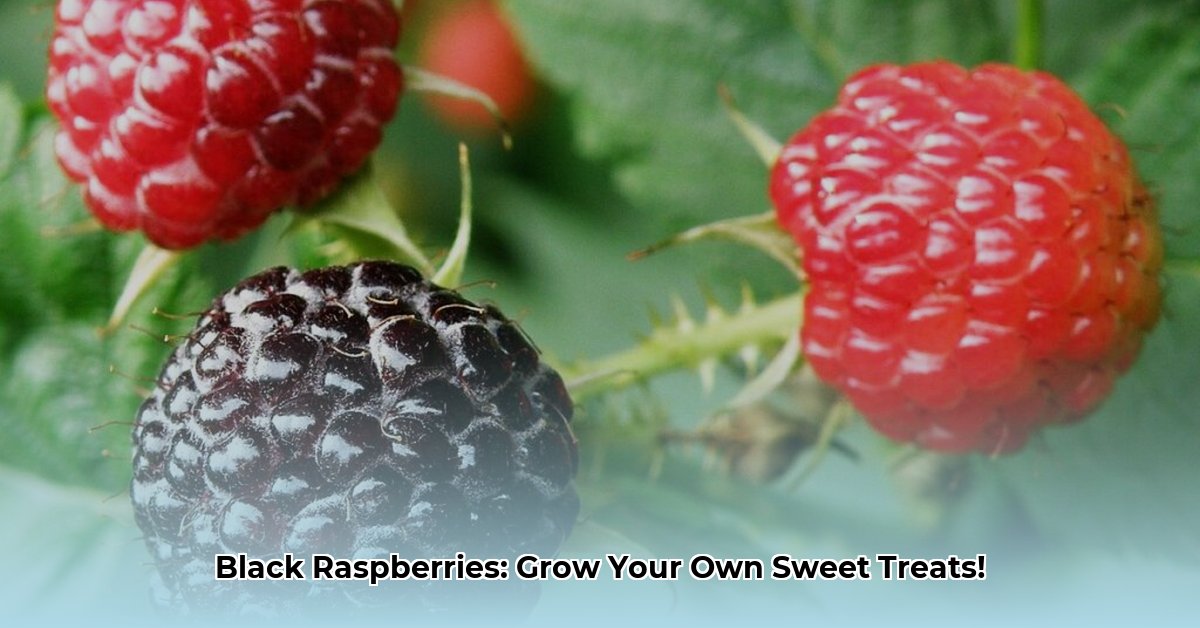Ready to enjoy the sweet taste of homegrown black raspberries? This comprehensive guide covers everything you need to know, from choosing the perfect spot in your yard to pruning, watering, and protecting your plants from pests. Whether you’re a seasoned gardener or just starting out, we’ll walk you through each step so you can enjoy a bountiful harvest.
Selecting Your Berry Patch Stars
Before you start digging, let’s talk varieties. The two main types of black cap raspberries are the Western black raspberry (Rubus leucodermis) and the Eastern black raspberry (Rubus occidentalis). Both produce those delectable dark berries, but their climate preferences differ slightly. Western types are generally more adaptable, flourishing in a wider range of conditions (USDA zones 1-8), while Eastern varieties prefer similar zones. Knowing your local climate will guide you to the best choice for your garden.
Planting Your Raspberry Treasures
Location, Location, Location
Black raspberries thrive in sunny locations, ideally with 6-8 hours of direct sunlight per day. Some afternoon shade might be beneficial in particularly hot climates. Well-drained soil is crucial; avoid heavy clay that can suffocate roots. A slightly acidic soil pH (5.5-6.5) is ideal. Adding compost or well-rotted manure can enhance soil structure and drainage.
Planting Techniques
The best time to plant is typically early spring, after the last frost, or in fall. Space plants about 2-1/2 to 3 feet apart to allow for growth and air circulation. A trellis or support system can be beneficial, particularly for vigorous varieties, keeping canes off the ground and improving air circulation. For bare-root plants, dig a hole wide enough to spread the roots, while potted plants should be planted at the same depth as their container. Water thoroughly after planting.
Nurturing Your Raspberry Patch
Watering Wisdom
Consistent watering is essential, particularly during dry spells. Aim for about 1 inch of water per week, including rainfall. Drip irrigation or soaker hoses are efficient options, delivering water directly to the roots and minimizing evaporation.
Feeding Your Plants
Fertilize in early spring with a balanced fertilizer or compost tea. Some gardeners suggest a light feeding after fruiting. Ongoing research explores the use of beneficial fungi to enhance raspberry growth, with some studies suggesting improved nutrient uptake, though more research is needed to understand this complex relationship fully.
Mulching Magic
A layer of mulch around the plants helps retain moisture, suppress weeds, and regulate soil temperature. Organic options like straw or wood chips are popular choices.
Pruning for a Bountiful Harvest
Pruning is crucial for maximizing berry production. It might seem drastic, but it encourages healthy growth and bigger, juicier berries.
First-Year Pruning (after planting):
Cut back canes to about 12 inches to promote root development.
Dormant Season Pruning (late winter/early spring):
Remove dead, damaged, or weak canes. Thin remaining canes, leaving 4-6 strong canes per plant, spaced about 6-12 inches apart.
Lateral Pruning (spring and summer):
Trim lateral branches to 8-10 buds in spring and pinch back new growth to 36 inches during summer to encourage fruiting.
Fall Pruning:
Repeat spring pruning, leaving 5-10 canes per plant. Cut back laterals to 4-7 inches to prepare for winter.
Protecting Your Plants
Pest and Disease Management
Regularly inspect your plants for signs of pests or diseases. Common pests include aphids, spider mites, and cane borers. Neem oil, insecticidal soap, and a strong stream of water can often control these. For diseases like anthracnose or powdery mildew, good sanitation and air circulation are key preventative measures. If problems persist, consult your local agricultural extension office.
Protecting from Wildlife
Birds and deer can also be a problem. Netting can protect against birds, while fencing is usually the most effective deterrent for deer.
Harvesting and Enjoying
Ripe black raspberries are a deep black color and easily detach from the stem with a gentle tug. Handle carefully to avoid bruising. Store uncovered in the refrigerator for up to 5 days.
Preserving the Bounty
Freezing, canning, drying, making jams and jellies—there are endless ways to enjoy your harvest year-round.
Propagating: Expanding Your Berry Patch
Black raspberries are easily propagated through tip-rooting. In late summer/early fall, bend a healthy cane to the ground and bury the tip a few inches deep. Keep the soil moist. Roots will develop, and the new plant can be separated and transplanted the following season.
Troubleshooting
| Problem | Possible Causes | Solutions |
|---|---|---|
| Yellowing leaves | Nutrient deficiency, over/under watering | Soil test, adjust watering, fertilize appropriately |
| Few berries | Insufficient pruning, lack of sunlight | Prune correctly, ensure adequate sunlight |
| Wilting canes | Root rot, drought | Improve drainage, water deeply during dry periods |
Resources
For more in-depth information, consult your local agricultural extension office or explore resources like the Old Farmer’s Almanac and Fine Gardening.
By following these guidelines, you’ll be well on your way to a thriving black raspberry patch. Happy gardening!
- Wellness Fair Ideas for Work to Boost Employee Wellbeing - December 15, 2025
- Affordable Employee Wellness Fair Ideas for Any Budget - December 14, 2025
- Employee Wellness Programs Strategically Benefit Employee Health And Retention - December 13, 2025
















